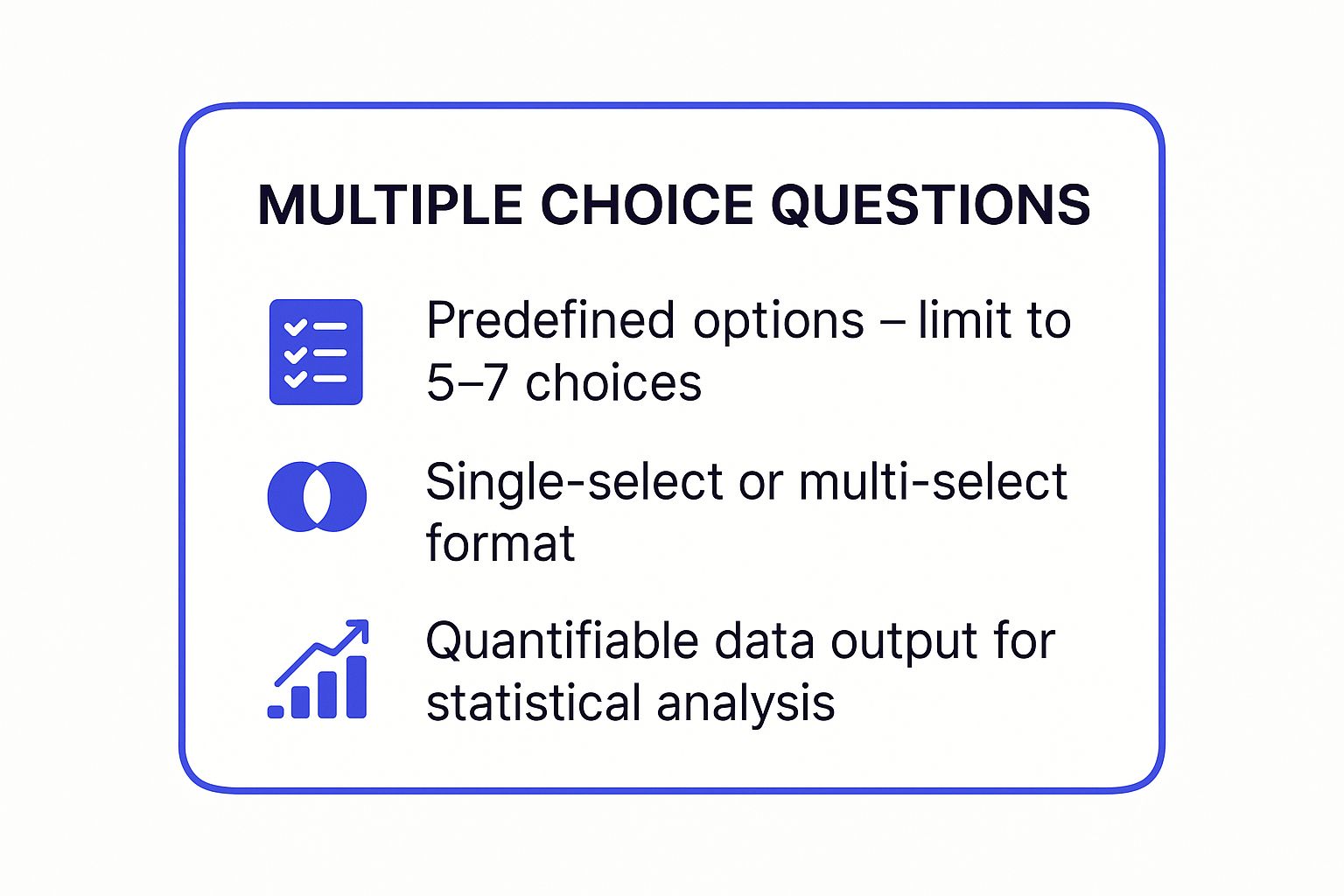8 Essential Types of Survey Questions to Use in 2025
Master the 8 essential types of survey questions for better data. Learn how to choose the right format for actionable insights and improved feedback collection.

Crafting a successful survey is more than just asking questions; it's about asking the right questions in the right way. The structure of your questions directly impacts the quality of data you collect, influencing everything from response rates to the strategic decisions you make. Choosing the wrong format can lead to ambiguous answers, frustrated respondents, and ultimately, useless data that hinders growth rather than fueling it.
This guide is designed for product teams, marketers, and founders who need actionable insights, not just raw numbers. We will move beyond the basics to provide a strategic breakdown of the essential types of survey questions. You will learn not only what each question type is but, more importantly, when and how to use it for maximum impact.
By understanding the specific strengths of each format, you can design surveys that capture nuanced feedback, reduce user friction, and deliver clear, quantifiable results. We'll explore the unique advantages of each, offer expert tips on implementation, and provide practical examples of how to build them effectively. This article will equip you to transform your feedback process from a simple data-gathering exercise into a powerful engine for strategic growth.
1. Multiple Choice Questions
Multiple choice questions are a foundational element in the world of survey design, making them one of the most essential types of survey questions to master. They provide respondents with a list of predefined answers, from which they can select one (single-select) or multiple options (multi-select). This structured format is invaluable for collecting clean, quantifiable data that can be easily analyzed and visualized.
Pioneered by polling experts like George Gallup, this question type excels at gathering straightforward data on preferences, demographics, and usage frequency. For instance, a SaaS company could use a single-select question to ask, "Which feature is most important to you?" This provides clear, unambiguous data on user priorities. Similarly, a multi-select question like, "Which of these integrations do you use daily?" allows product teams to understand which tools are critical to their users' workflows.
Best-Use Scenarios & Key Benefits
The primary advantage of multiple choice questions is their simplicity for both the creator and the respondent. This leads to higher completion rates and data that is easy to segment and analyze.
- When to Use: Ideal for gathering demographic information (age, income), measuring preferences, or when you have a clear, finite set of possible answers. Companies like Apple and Amazon use a variation of this in their Net Promoter Score (NPS) surveys, which is a specialized multiple-choice format.
- Key Benefit: They produce structured, quantitative data that eliminates ambiguity. This simplifies statistical analysis, allowing you to quickly identify trends and patterns in responses without needing to code qualitative text.
For a deeper dive into crafting effective questions, Surva.ai offers a wealth of examples. You can explore more detailed applications and learn more about Multiple Choice Questions here.
Practical Tips for Implementation
To maximize the effectiveness of your multiple choice questions, consider these actionable tips:
Key Takeaway: Ensure your answer options are both mutually exclusive (no overlap) and collectively exhaustive (all possibilities are covered). If you can't cover every possibility, include an "Other (please specify)" option to capture outlier responses.
Additionally, limit the number of choices to between five and seven to avoid overwhelming the respondent, a phenomenon known as choice overload. Randomizing the order of the answers can also help mitigate order bias, where respondents tend to select the first or last options more frequently.
The infographic below summarizes the core components of a well-structured multiple choice question.

As highlighted, the strength of this question type lies in its predefined options and its ability to yield easily analyzable data, whether through single or multi-select formats.
2. Likert Scale Questions
Likert scale questions are a cornerstone for measuring attitudes and opinions, making them one of the most powerful types of survey questions available. They ask respondents to rate their level of agreement, satisfaction, or frequency on a balanced, multi-point scale. This format, developed by psychologist Rensis Likert, transforms subjective feelings into quantifiable data, perfect for nuanced analysis.
This question type is pivotal for understanding the intensity of a respondent's feelings. For example, a customer experience team at a company like Starbucks might ask, "How satisfied were you with your recent in-store experience?" using a 5-point scale from 'Very Unsatisfied' to 'Very Satisfied'. Similarly, employee engagement firms like Gallup utilize Likert scales to gauge sentiments such as, "I feel my contributions are valued at work," with options from 'Strongly Disagree' to 'Strongly Agree'.
Best-Use Scenarios & Key Benefits
The main advantage of Likert scales is their ability to capture the degree of sentiment rather than just a simple yes/no answer. This provides deeper, more actionable insights into perceptions and attitudes.
- When to Use: Ideal for measuring satisfaction, agreement, likelihood, or importance. They are frequently used in employee engagement surveys, customer feedback forms, and academic research to get a granular view of opinions.
- Key Benefit: They provide quantitative data on qualitative subjects. This structure allows you to calculate mean scores and perform statistical analysis to track changes in attitude or satisfaction over time, offering a more precise understanding of your audience.
For a comprehensive guide on constructing these scales effectively, Surva.ai offers numerous examples. You can find more detailed applications and learn more about Likert Scale Questions here.
Practical Tips for Implementation
To get the most accurate data from your Likert scale questions, careful design is crucial. Follow these best practices to ensure clarity and reliability.
Key Takeaway: Maintain consistency in your scale's direction (e.g., always place 'Strongly Disagree' on the left and 'Strongly Agree' on the right) throughout the survey. This prevents respondent confusion and ensures data integrity.
Also, be sure to label each point on the scale, not just the endpoints, to clarify the meaning of each option. While a 5-point scale is common, a 7-point scale can offer more precision for detailed analysis. Finally, consider including a few reverse-coded items (where the positive statement is phrased negatively) to ensure respondents are paying close attention and not just mindlessly selecting the same answer.
3. Open-Ended Questions
Open-ended questions are a pivotal tool in survey design, representing one of the most insightful types of survey questions available. Unlike structured formats, they invite respondents to answer in their own words, providing a text box for free-form responses. This approach is essential for gathering rich, qualitative data that reveals the "why" behind customer actions and opinions.

Popularized by qualitative research pioneers like Ernest Dichter, this question type is designed to uncover nuanced feedback, unforeseen issues, and detailed suggestions. For example, a customer-centric company like Zappos might ask, "What is one thing we could do to improve your next shopping experience?" This uncovers specific, actionable insights that a multiple choice question would miss, allowing for genuine customer-led innovation.
Best-Use Scenarios & Key Benefits
The core advantage of open-ended questions is their ability to capture authentic, detailed feedback directly from the source. This provides deep context that quantitative data alone cannot offer, making them invaluable for exploratory research.
- When to Use: Perfect for follow-up questions to a quantitative rating (e.g., after an NPS score), user experience research, employee exit interviews, or any situation where you want to discover unknown factors or deep-seated motivations.
- Key Benefit: They provide rich, qualitative insights and can reveal unexpected issues or opportunities. This raw feedback is a goldmine for product development, customer service improvements, and understanding the complete customer journey.
For more guidance on how to phrase these questions effectively, Surva.ai offers a comprehensive guide. You can explore a variety of applications and find an example of an open-ended question to inspire your next survey.
Practical Tips for Implementation
To get the most value from your open-ended questions, it's crucial to be strategic in their application.
Key Takeaway: Ask specific and focused questions to guide the respondent. Instead of a vague "Any feedback?", ask "What was the most frustrating part of your onboarding experience today?" to elicit a more useful, targeted response.
Be mindful of survey fatigue by limiting the number of open-ended questions you include; one to three is often sufficient. For online surveys, consider setting a reasonable character limit to encourage concise answers. When analyzing the results from large datasets, use text analysis tools to identify common themes and sentiments efficiently.
4. Rating Scale Questions
Rating scale questions are a powerful tool in the arsenal of types of survey questions, asking respondents to evaluate a specific item, service, or experience on a numerical scale. Unlike Likert scales that focus on agreement, rating scales are designed to measure concepts like quality, satisfaction, likelihood, or importance. This format provides granular, interval data that is easy to quantify and compare across different segments.
This question type was famously popularized by customer experience pioneers like Fred Reichheld with the creation of the Net Promoter Score (NPS), which uses a 0-10 scale. You see this in action everywhere, from Amazon's product star ratings and IMDb's movie scores to Tesla's customer satisfaction surveys. These companies leverage rating scales to turn subjective opinions into clear, actionable metrics that guide business decisions and product development.
Best-Use Scenarios & Key Benefits
The core strength of rating scale questions is their ability to generate precise quantitative feedback that can be easily benchmarked over time. This makes them indispensable for tracking performance and customer sentiment.
- When to Use: Perfect for measuring customer satisfaction (CSAT), product quality, likelihood to recommend (NPS), or the importance of a feature. E-commerce platforms like Amazon and review sites like Yelp have built their entire review systems around this model.
- Key Benefit: They produce standardized, comparable data that is simple to analyze statistically. You can calculate averages, track trends, and segment results to see how different user groups feel, all without the heavy lifting required for qualitative analysis.
For those looking to implement these scales effectively, Surva.ai offers robust tools for creating and distributing such surveys. You can find detailed guides and examples on how to build powerful Rating Scale Questions here.
Practical Tips for Implementation
To ensure your rating scale questions yield accurate and reliable data, follow these best practices:
Key Takeaway: Clearly label the endpoints of your scale to define what the numbers mean. For instance, a 1-10 scale should explicitly state that 1 means "Not at all Satisfied" and 10 means "Extremely Satisfied." This removes ambiguity and ensures all respondents interpret the scale the same way.
Furthermore, maintain a consistent scale range throughout your survey (e.g., always use 1-5 or 0-10) to make it easier for respondents to answer and for you to compare results across different questions. Consider following up a low rating with an open-ended question like, "Could you tell us why you gave this rating?" to capture valuable qualitative context.
5. Ranking Questions
Ranking questions are a powerful tool among the different types of survey questions, designed to gauge the relative importance or preference of a set of items. Respondents are asked to arrange a list of options in a specific order, such as from most to least important, or most to least preferred. This forces them to make trade-offs, providing rich, comparative data that goes beyond simple ratings.

Popularized by market researchers and strategic planners, this format is excellent for understanding decision-making criteria. For example, a software company like Microsoft could use a ranking question to ask users to prioritize upcoming features. This reveals not just what features are liked, but which ones are most critical, helping product teams allocate resources effectively. Similarly, an HR department can use ranking questions to determine which employee benefits are most valued by the team.
Best-Use Scenarios & Key Benefits
The primary advantage of ranking questions is their ability to reveal the hierarchy of preferences, which is something multiple choice or rating scale questions cannot do. This makes them ideal for prioritization and strategic decision-making.
- When to Use: Perfect for feature prioritization, understanding brand perceptions, and identifying key drivers of customer satisfaction. They are also used extensively in academic settings for program evaluations and by financial firms to rank investment priorities.
- Key Benefit: They provide clear, ordinal data that shows the relative standing of each item. This helps you understand not just what people like, but how much more they like one option over another, eliminating the issue of all items receiving high ratings.
Practical Tips for Implementation
To get the most out of your ranking questions, proper design is crucial to avoid respondent fatigue and ensure accurate data collection.
Key Takeaway: Limit the number of items to rank to between five and seven. A longer list can become cognitively demanding, leading to incomplete or inaccurate responses. For online surveys, a drag-and-drop interface is highly recommended for a better user experience.
If a longer list is unavoidable, consider asking respondents to only rank their top three or five choices. Always provide clear, concise instructions on how to complete the ranking task.
The video below offers a visual guide on setting up and analyzing ranking questions within a survey platform.
As demonstrated, the strength of ranking questions lies in their ability to force a comparative judgment, delivering invaluable insights into what truly matters most to your audience.
6. Dichotomous Questions
Dichotomous questions represent one of the most direct and simple types of survey questions, providing respondents with only two opposing choices. These binary options are typically formatted as 'Yes/No,' 'True/False,' or 'Agree/Disagree,' creating a straightforward path for collecting unambiguous data. This question type is fundamental for screening participants or gathering definitive factual information without any gray areas.
Pioneered by census organizations and political pollsters, this format is highly effective for clear-cut data collection. For instance, a customer success team might use a dichotomous question to ask, "Did our support team resolve your issue on the first contact?" This provides a clear, measurable metric for first-contact resolution. Similarly, a screening question like, "Have you used our software in the last 30 days?" allows researchers to filter out irrelevant respondents and focus their analysis on active users.
Best-Use Scenarios & Key Benefits
The primary strength of dichotomous questions is their simplicity, which reduces respondent fatigue and yields data that is incredibly easy to analyze. They serve as excellent gateways to more detailed follow-up questions.
- When to Use: Perfect for screening questions, verifying facts, or measuring agreement with a clear statement. They are essential for implementing skip logic in surveys, where a user's 'Yes' or 'No' answer directs them to a different set of relevant questions.
- Key Benefit: They eliminate ambiguity and produce clean, binary data. This simplicity makes them ideal for calculating percentages and tracking straightforward metrics, such as the adoption rate of a new feature or eligibility for a beta program.
For those looking to build efficient screening flows, Surva.ai provides powerful tools. You can learn more about applying skip logic with Dichotomous Questions here.
Practical Tips for Implementation
To get the most out of your dichotomous questions, precision and context are key. Follow these guidelines for optimal results:
Key Takeaway: Keep the question wording direct and focused on a single concept. Avoid double-barreled questions like, "Was our service fast and helpful?" as a respondent might agree with one part but not the other, leading to inaccurate data.
Ensure your two options are truly mutually exclusive. In situations where a respondent might genuinely not know the answer, consider adding a neutral third option like "Not Sure" or "I don't know" to prevent forced, inaccurate responses. Use these questions to set up conditional paths, asking a follow-up open-ended question like, "If yes, could you tell us more?" to gather valuable context.
7. Matrix Questions
Matrix questions are a powerful tool for efficiently gathering data on multiple related items, solidifying their place among the essential types of survey questions. Also known as grid questions, they present a series of questions in a grid or table format, where respondents use the same scale to evaluate each item. This structured approach is ideal for reducing survey length while collecting comprehensive feedback on various attributes.
Popularized by market researchers and survey software companies, this format excels at evaluating a group of related concepts. For example, a customer success team could use a matrix to ask customers to rate their satisfaction with different aspects of a service, like "Response Time," "Knowledge of Staff," and "Resolution Quality," all on a single "Very Satisfied" to "Very Dissatisfied" scale. This consolidates multiple questions into one compact, easy-to-read block.
Best-Use Scenarios & Key Benefits
The main advantage of matrix questions is their ability to streamline the survey experience by grouping similar items, which reduces respondent fatigue and cognitive load. This often leads to quicker survey completion without sacrificing data depth.
- When to Use: Perfect for evaluating a set of product features, measuring satisfaction across multiple service touchpoints, or assessing agreement with a series of related statements. HR departments often use them in employee performance evaluations to rate various competencies using a consistent scale.
- Key Benefit: They produce structured, comparable data that is incredibly efficient to analyze. You can easily compare responses across different items (rows) to see which attributes perform best or worst, simplifying trend identification and reporting.
To see how matrix questions can be implemented in a real-world setting, Surva.ai offers practical examples. You can learn more about crafting effective Matrix Questions here.
Practical Tips for Implementation
To get the most out of your matrix questions, it's crucial to design them thoughtfully to avoid common pitfalls like respondent confusion or bias.
Key Takeaway: Keep your matrices focused and concise. Limit the number of row items to between five and seven to prevent overwhelming respondents, and ensure all items are genuinely related to the overarching question and scale.
Furthermore, always use clear, unambiguous labels for both rows and columns. To mitigate order bias, randomize the order of the row items for each respondent. Finally, consider the mobile experience; long matrix questions can be difficult to navigate on small screens, so test them or consider breaking them into simpler question types for mobile users.
8. Semantic Differential Questions
Semantic differential questions offer a nuanced way to gauge attitudes and perceptions, making them one of the more powerful types of survey questions for branding and user experience research. Instead of a simple agreement scale, this format asks respondents to rate a concept on a multi-point scale anchored by two opposite, or bipolar, adjectives. This captures the subtle, connotative meaning that people associate with a brand, product, or idea.
Developed by psychologist Charles Osgood, this technique is a favorite among advertising agencies and brand managers. For instance, a tech company could ask users to rate its new software on a scale from "Innovative" to "Conventional," or a car manufacturer might measure perceptions of a new model from "Affordable" to "Luxurious." These questions provide rich, emotional data that goes beyond simple preference.
Best-Use Scenarios & Key Benefits
The main strength of semantic differential questions is their ability to map out the perceptual space of a concept. They reveal not just what people think, but how they feel, which is invaluable for brand positioning and competitive analysis.
- When to Use: Ideal for brand perception studies, measuring corporate image, product positioning research, or evaluating user experience. Political campaigns often use this method to assess a candidate's perceived image on scales like "Trustworthy" vs. "Untrustworthy."
- Key Benefit: This format produces powerful data for perceptual mapping and competitive analysis. You can visually plot your brand against competitors based on multiple attribute pairs, instantly revealing strengths, weaknesses, and market opportunities.
For a comprehensive guide on building these and other advanced surveys, Surva.ai offers robust tools and templates. You can explore how to apply these techniques at Surva.ai.
Practical Tips for Implementation
To get meaningful results from semantic differential questions, the choice of adjectives is critical. Follow these guidelines for effective implementation:
Key Takeaway: Your bipolar adjectives must be true opposites. Test pairs like "Modern vs. Traditional" or "Simple vs. Complex" with a small group from your target audience to ensure they are interpreted as intended and are culturally relevant.
Also, be sure to keep the scale direction consistent throughout the survey (e.g., always place the "positive" adjective on the right) to avoid confusing respondents. Randomizing the order in which the adjective pairs are presented can help minimize any potential order bias in the responses.
Comparison of 8 Survey Question Types
From Questions to Growth: Your Next Steps
You've now explored the essential toolkit of data collection: the core types of survey questions that power modern feedback strategies. From the structured precision of Multiple Choice and Likert Scale questions to the rich, narrative depth of Open-Ended inquiries, each format serves a unique purpose. The true artistry, however, lies not in knowing these types, but in skillfully weaving them together to create a survey that tells a complete story.
Mastering this skill transforms your feedback loop from a passive data-gathering exercise into an active engine for growth. A well-designed survey is more than a list of questions; it's a strategic conversation with your users. It allows you to move beyond surface-level satisfaction scores and uncover the "why" behind user behavior, which is the cornerstone of building products that customers love and refuse to leave.
Bridging the Gap Between Data and Action
The ultimate goal isn't just to collect answers. It's to convert those answers into actionable intelligence that informs your product roadmap, enhances customer success initiatives, and sharpens your marketing message. The right mix of questions provides both quantitative benchmarks and qualitative context, a powerful combination for any SaaS team.
Think of it this way:
- Ranking and Matrix questions can help you prioritize feature development by revealing what users value most.
- Semantic Differential scales can measure subtle shifts in brand perception after a marketing campaign.
- Open-Ended questions, analyzed with AI, can flag at-risk customers by identifying key themes of frustration or confusion.
This strategic approach ensures your efforts are always aligned with user needs. To effectively gather insights and streamline the process, consider options for integrating best survey tools like Typeform directly into your team's existing workflows, such as your internal wiki or project management software. Centralizing feedback makes it accessible and actionable for everyone, from product managers to customer support agents.
Ultimately, understanding the different types of survey questions is your first step toward building a customer-centric culture. It empowers you to ask better questions, which leads to better data, smarter decisions, and sustainable growth. Don't just send surveys; architect conversations that build loyalty, reduce churn, and turn user feedback into your most valuable competitive advantage. Your next breakthrough product feature or marketing campaign is waiting to be discovered in your next survey response.
Ready to turn these insights into action? Surva.ai is built to help you deploy intelligent surveys using all the question types discussed, analyze responses with powerful AI, and automate workflows based on user feedback. Start building smarter surveys today and transform feedback into growth at Surva.ai.


